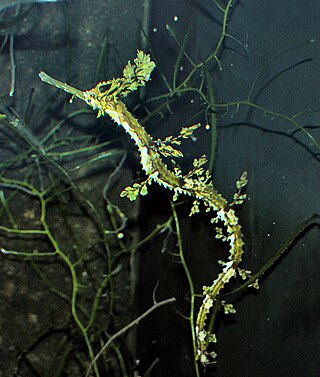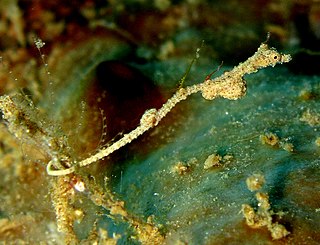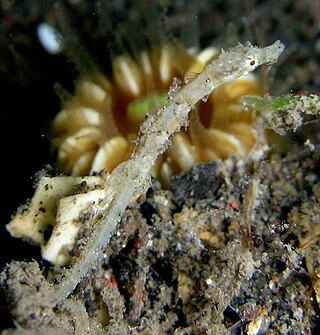
The Microhylidae, commonly known as narrow-mouthed frogs, are a geographically widespread family of frogs. The 683 species are in 57 genera and 11 subfamilies.

African tetras are a group of characiform fish found exclusively in Africa. This family contains about 18 genera and 119 species. Among the best known members are the Congo tetra, and African tigerfish.

Pipefishes or pipe-fishes (Syngnathinae) are a subfamily of small fishes, which, together with the seahorses and seadragons, form the family Syngnathidae.

Oreochromis is a large genus of oreochromine cichlids, fishes endemic to Africa and the Middle East. A few species from this genus have been introduced far outside their native range and are important in aquaculture. Many others have very small ranges; some are seriously threatened, and O. ismailiaensis and O. lidole possibly are extinct. Although Oreochromis primarily are freshwater fish of rivers, lakes and similar habitats, several species can also thrive in brackish waters and some even survive in hypersaline conditions with a salinity that far surpasses that of seawater. In addition to overfishing and habitat loss, some of the more localized species are threatened by the introduction of other, more widespread Oreochromis species into their ranges. This is because they—in addition to competing for the local resources—often are able to hybridize.

The spiny pipehorse is a pipefish of the family Syngnathidae, found in the southwest Pacific Ocean on rocky or coral reefs to depths of 230 metres (750 ft). Length is up to 50 centimetres (20 in).

The southern little pipehorse is a species of fish in the family Syngnathidae. It is endemic to Australia. Its natural habitats are open seas, shallow seas, subtidal aquatic beds, and coral reefs. It camouflages amongst species of red algae. It is threatened by habitat loss.

Idiotropiscis is a genus of pygmy pipehorse endemic to Australia. They are commonly called pygmy pipehorses due to their small size.
Hardwicke's pipefish or pallid seahorse is a species of fish in the family Syngnathidae. It is found in Australia, China, Indonesia, Japan, Malaysia, Mauritius, the Philippines, Thailand, and Vietnam. Its natural habitats are open seas, shallow seas, subtidal aquatic beds, and coral reefs. It is threatened by habitat loss.
Günther's pipehorse is a species of fish in the family Syngnathidae. It is found in Australia and Indonesia.

Pristiophorus is a genus of sawsharks found in the Pacific, Atlantic and Indian oceans. Members of this genus differ from the Sixgill Sawshark (Pliotrema warreni) in having five gill slits. Their rostral sawteeth lack prominent transverse ridges on the basal ledges, and the large teeth are not posteriorly serrated.
S. robustus may refer to:

The Hippocampinae are a subfamily of small marine fishes in the family Syngnathidae. Depending on the classification system used, it comprises either seahorses and pygmy pipehorses, or only seahorses.

Acentronura is a genus of pygmy pipehorse native to the Indian and Pacific oceans. The name is derived from the Greek ακεντρονουρα, or a-kentron-oura, and refers to the lack of a sting on the tail.

The ribboned pipefish, ribboned pipehorse or ribboned seadragon, is a species of pipefish found along the coast of northern Australia and New Guinea in habitats ranging from shallow and weedy to deeper and sandy bottoms down to depths of 16.5 m (54 ft). This species grows to a total length of 30 cm (12 in). Their colors can range from greenish yellow to brownish red. This species is the only known member of its genus.
Amphelikturus dendriticus, the pipehorse, is a species of pygmy pipehorse native to the western Atlantic Ocean. This small, highly camouflaged pipefish is rarely seen. This species grows to a length of 7.5 centimetres (3.0 in) TL. This species is the only known member of its genus.

The thread pipefish, also known by its Japanese standard name Hari-youji, is a species of pipefish native to the Pacific Ocean around Indonesia, where it is found at depths from 15 to 20 m. This species grows to a length of 2.68 cm (1.06 in), and is the only known member of its genus.

Acentronura tentaculata, the shortpouch pygmy pipehorse , northern little pipehorse, or dwarf pipehorse, is a species of pygmy pipehorse from the family Syngnathidae. The status of this species is debated and Acentronura breviperula is considered to be subsumed within this species by some authorities. The exact distribution of this species may be as wide as the western Indo-Pacific region from East Africa to New Caledonia and the northern Great Barrier Reef. Other authorities however describe Acentronura tentaculata as being endemic to the Red Sea.
Paul Georg Egmont Duncker was a German ichthyologist.

Acentronura breviperula, also known as the shortpouch pygmy pipehorse, dwarf pipehorse and northern little pipehorse, is a species of pygmy pipehorse, a member of the family Syngnathidae, the seahorses and pipefishes. It occurs in the Indo-Pacific region from the eastern Andaman Sea, through the Malay Archipelago to the Western Pacific as far east as New Guinea and the northern Great Barrier Reef.
Cylix tupareomanaia, the Manaia pygmy pipehorse, is a species of syngnathid, the family of seahorses and pipefish, and is endemic to New Zealand. It was first described in 2021, and is found in the northern parts of the North Island of New Zealand.












